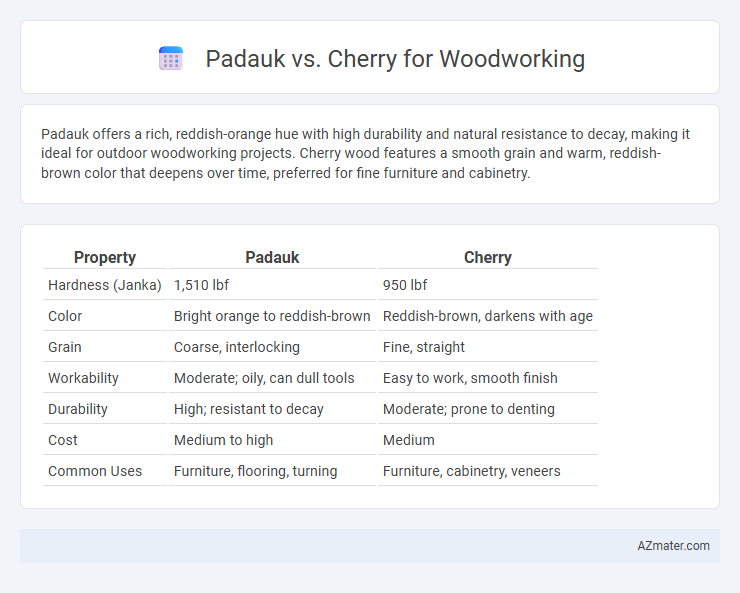Padauk offers a rich, reddish-orange hue with high durability and natural resistance to decay, making it ideal for outdoor woodworking projects. Cherry wood features a smooth grain and warm, reddish-brown color that deepens over time, preferred for fine furniture and cabinetry.
Table of Comparison
| Property | Padauk | Cherry |
|---|---|---|
| Hardness (Janka) | 1,510 lbf | 950 lbf |
| Color | Bright orange to reddish-brown | Reddish-brown, darkens with age |
| Grain | Coarse, interlocking | Fine, straight |
| Workability | Moderate; oily, can dull tools | Easy to work, smooth finish |
| Durability | High; resistant to decay | Moderate; prone to denting |
| Cost | Medium to high | Medium |
| Common Uses | Furniture, flooring, turning | Furniture, cabinetry, veneers |
Introduction: Padauk vs Cherry Wood
Padauk and cherry wood are both popular choices in woodworking, known for their distinct grain patterns and durability. Padauk exhibits a vibrant reddish-orange hue that darkens to a rich brown over time, while cherry wood is prized for its smooth texture and warm, reddish-brown color that deepens with age. Both woods offer excellent workability and finishing qualities, making them favored materials for furniture, cabinetry, and decorative projects.
Overview of Padauk Wood Characteristics
Padauk wood is renowned for its vibrant reddish-orange color that deepens with age, making it a popular choice for striking woodworking projects. Its dense and hard texture provides exceptional durability and resistance to wear, suitable for furniture, flooring, and turnery. The wood's fine grain structure allows for smooth finishes, while its natural oils contribute to stability and resistance against decay and insect attacks.
Overview of Cherry Wood Characteristics
Cherry wood is a hardwood known for its rich, warm reddish-brown color that deepens with age and exposure to light, making it highly desirable for fine furniture and cabinetry. It offers a smooth, fine, and straight grain with occasional waves, providing an elegant appearance and excellent workability for hand and machine tools. Cherry wood has moderate hardness and durability, making it suitable for interior applications while offering good resistance to warping and shrinking.
Color and Appearance Comparison
Padauk wood is known for its vibrant, striking reddish-orange hues that deepen to a rich, dark reddish-brown over time, offering a bold and exotic appearance, while Cherry wood displays a warm, reddish-brown color that gradually mellows to a rich, deep patina with age. The fine, straight grain of Padauk often has a coarse texture with occasional wavy patterns, contrasting with Cherry's smooth, fine grain and uniform texture that is highly prized for elegant woodworking projects. Both woods develop a lustrous finish when polished, but Padauk's more vivid coloration makes it ideal for statement pieces, whereas Cherry's subtle, classic elegance suits traditional and refined furniture designs.
Workability and Machining Differences
Padauk wood offers superior workability due to its moderate density and natural oils, allowing smoother cutting and shaping with less tool wear compared to Cherry. Cherry, being slightly softer and less oily, machines cleanly but tends to gum up tools more quickly, requiring frequent sharpening. Both woods finish beautifully, yet Padauk's dimensional stability and resistance to warping make it more favorable for detailed and precision woodworking projects.
Durability and Hardness: Padauk vs Cherry
Padauk wood exhibits exceptional durability and hardness, often rated around 2,200 on the Janka scale, making it highly resistant to wear, dents, and scratches compared to Cherry, which typically measures about 995 on the same scale. This significant difference in hardness means Padauk is better suited for heavy-use applications like flooring and furniture that must withstand frequent impact. While Cherry offers a smoother finish and easier workability, Padauk's superior toughness ensures longer-lasting performance in demanding woodworking projects.
Finishing and Staining Results
Padauk wood exhibits a vibrant reddish-orange hue that deepens to a rich mahogany when finished, providing excellent stain absorption and a smooth surface ideal for fine woodworking. Cherry wood offers a warm, golden-brown tone that darkens naturally with age and finishing, delivering a consistent grain that enhances stain uniformity and polish. Both woods respond well to sealing and clear coats, but Padauk's bold color often requires a neutral finish to preserve its intensity, while Cherry benefits from oil finishes that highlight its subtle grain patterns.
Common Applications in Woodworking
Padauk wood is favored in woodworking for its vibrant reddish-orange hue, commonly used in decorative veneers, musical instruments, and fine furniture that require a striking aesthetic appeal. Cherry wood excels in cabinetry, flooring, and carving due to its smooth grain, rich warm tones, and excellent workability, making it a staple for classic and elegant wood projects. Both woods are durable, but Padauk offers superior resistance to decay, ideal for outdoor or high-moisture applications compared to Cherry's indoor-focused usage.
Cost and Availability Considerations
Padauk wood generally costs more than cherry due to its exotic origin and vibrant reddish-orange hue, which increases demand among woodworkers seeking distinctive finishes. Cherry is widely available in North America, making it a more affordable and accessible option for large-scale projects or budget-conscious craftsmen. While padauk's limited supply and import costs drive its price higher, cherry benefits from sustainable forestry practices that maintain steady availability and competitive pricing.
Choosing the Best Wood for Your Project
Padauk offers vibrant reddish-orange hues and exceptional durability, making it ideal for outdoor furniture and decorative projects that require weather resistance. Cherry wood is prized for its smooth grain, rich warm tones, and excellent workability, perfect for fine cabinetry and indoor furniture with a polished finish. Choosing between Padauk and Cherry depends on your project's exposure to elements and desired aesthetic, with Padauk suited for rugged, high-impact uses and Cherry favored for elegant, detailed woodworking.

Infographic: Padauk vs Cherry for Woodworking
 azmater.com
azmater.com